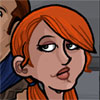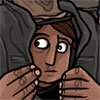Join the cast of Another Videogame Webcomic as we peek behind the curtain to see what exactly goes into bringing your favorite video games to the small screen. It may be a job in video games, but it's still a job.
LEGO Star Wars III: The Clone Wars
Platform: Nintendo Wii, DS, 3DS, PC, Sony Playstation 3, PSP, Xbox 360Price: $49.99 (PS3, Xbox 360, Wii), $39.99 (3DS), $29.99 (DS, PC, PSP)
In theory, the LEGO Star Wars franchise is for kids. It’s cute, it’s got pretty simple game mechanics and it’s based on a wildly popular sci-fi/fantasy property. So why oh why did it take me a half hour to beat the tutorial level?
It wasn’t exceptionally difficult, after all, it is at its core a hack and slash platformer. Maybe it was the fact that it is primarily based on the Clone Wars animated series (which I haven’t watched at all) and I wasn’t familiar enough with what was going on in the game? No, after futilely swinging my lightsaber for entirely too long, I realized what I was missing, what I was eagerly waiting for... a little direction.
For all it’s cutesy kid appeal, I’m not sure how LEGO Star Wars III would play with the intended age group (and I have no idea what that intended age group is). I eventually figured out what I needed to do in the tutorial, but I discovered it on my own with dumb luck. The lack of hand holding isn’t only in the tutorial level either. Many of the levels had similar objectives that weren’t immediately apparent, or goals that you’re never quite sure how to accomplish so you try everything and see what sticks. It got to the point where I could only play the game in short bursts because I would get so frustrated with the level that I’d need some downtime.
One of the culprits, I suspect, is the fact that you can play the various levels in whatever order you want. There are three paths you can choose from, each of which follow stories from the Clone Wars. But not all of the missions are your straight hack and slash. Because it’s Star Wars, space battles have been thrown into the mix. The space battles switch between flying an attack ship and landing to complete some ill-defined objective.
But what seems like a radical departure from the LEGO series is the simplified real time strategy levels. Here like in your standard RTS, you farm resources (in this case, LEGO studs) and build troops, cannons and vehicles to destroy your enemy’s own troops, cannons and vehicles to capture their areas of influence or destroy specific targets. The RTS levels certainly give the game a sense of scale and grandeur a game about intergalactic civil war should have and they’re pretty fun to boot. But again, the first time I encountered one of these levels, there wasn’t any clear instruction on what to do. I eventually figured out it was an RTS, but I wonder how someone would fare if they hadn’t played an RTS before?
Like with all of the other LEGO games, collection is a big part of replayability factor of LEGO Star Wars III. There are a few dozen of characters and ships to unlock. Some are fairly cosmetic changes while others allow you access to alternate parts of the levels. You’ll be compelled to play the game over again just to explore the levels and find all the stuff that was inaccessible the first time around. If you’re looking to get the most out of your gaming dollar, you can’t go wrong here, since this game is as densely packed as I’ve ever seen.
Rating
I have to say, this game was really hard for me to get into but once I got over the learning curve, I started to have some fun with it. It’s both fun and frustrating at various points in the game. I’d recommend a “rent”. Try it and see if you can wade through the initial frustration and get to the core of the game’s charm.Player Two
 After the resurgence of multiplayer co-op, GameBizCo Inc. hired Player Two to be the Goose to someone else's Maverick. His workload isn't quite as heavy as most of the other people working at GameBizCo Inc. and as a result, he spends a lot of time in the break room or playing computer solitaire.
After the resurgence of multiplayer co-op, GameBizCo Inc. hired Player Two to be the Goose to someone else's Maverick. His workload isn't quite as heavy as most of the other people working at GameBizCo Inc. and as a result, he spends a lot of time in the break room or playing computer solitaire.
First Appearance: Another Videogame Webcomic?!? An Introduction
Player One
 Player One is top dog at GameBizCo Inc. Nearly every game, from Pong to Mario Bros to Grand Theft Auto, requires Player One's expertise. His cocksure and sometimes inappropriate attitude is an annoyance to his coworkers but seeing as every game needs a first player, they make due.
Player One is top dog at GameBizCo Inc. Nearly every game, from Pong to Mario Bros to Grand Theft Auto, requires Player One's expertise. His cocksure and sometimes inappropriate attitude is an annoyance to his coworkers but seeing as every game needs a first player, they make due.
First Appearance: Bonus Stage! Here comes Player One!
Damsel I. Distress
 Whether it be a castle, a dungeon or mystical island, Damsel always needs to be saved... and she hates it. Damsel longs for the day when she's given the role of a strong female lead character who doesn't have huge breasts with hyper accurate physics.
Whether it be a castle, a dungeon or mystical island, Damsel always needs to be saved... and she hates it. Damsel longs for the day when she's given the role of a strong female lead character who doesn't have huge breasts with hyper accurate physics.
First Appearance: LittleBIGPlanet
Final Boss
 Underneath the huge brute that is Final Boss lies a timid creature who wouldn't hurt a fly. He puts on his "angry face" when throwing barrels down ramps or breathing fire but deep down he feels sorry for doing so. He's been known to throw a game or two in the player's favor.
Underneath the huge brute that is Final Boss lies a timid creature who wouldn't hurt a fly. He puts on his "angry face" when throwing barrels down ramps or breathing fire but deep down he feels sorry for doing so. He's been known to throw a game or two in the player's favor.
First Appearance: World Record
John Minion
 John Minion, or Min for short, is the hardest working employee at GameBizCo Inc. Playing everything from Goombas to no name thugs, Min gets beat up on a daily basis but loves every minute of it. He always wanted to work in the gaming industry and was originally hired as an intern. After years of getting coffee, his big break came when someone called in sick... and the rest is history.
John Minion, or Min for short, is the hardest working employee at GameBizCo Inc. Playing everything from Goombas to no name thugs, Min gets beat up on a daily basis but loves every minute of it. He always wanted to work in the gaming industry and was originally hired as an intern. After years of getting coffee, his big break came when someone called in sick... and the rest is history.
First Appearance: Watchmen: The End is Nigh
Middle Manager
 Middle Manager works in the Human Resources department. He runs staff meetings and interviews prospective employees. The other 90% of his time is spent playing Freecell on his computer.
Middle Manager works in the Human Resources department. He runs staff meetings and interviews prospective employees. The other 90% of his time is spent playing Freecell on his computer.
First Appearance: Another Videogame Webcomic?!? An Introduction


